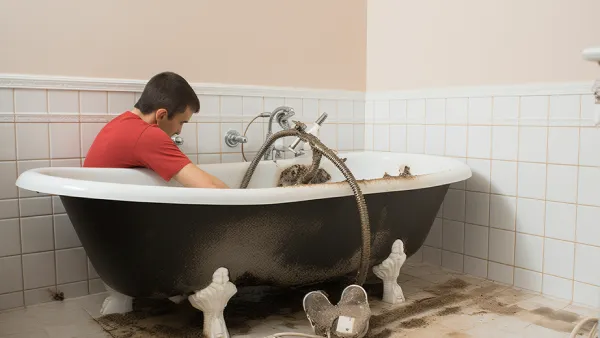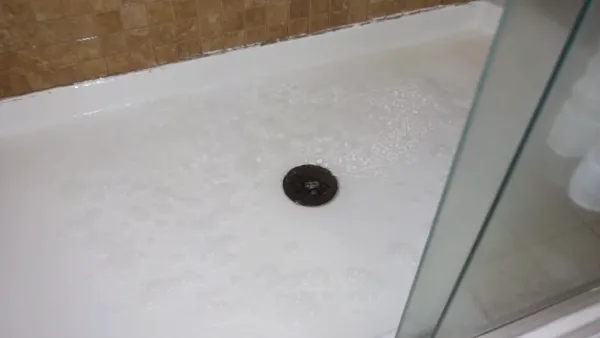Last Updated on September 7, 2023
A sewage backup not only creates an unpleasant odor but it can also pose serious health risks. Dealing with a sewage backup in your bathtub can be an unsanitary experience. Therefore, it is essential to clean up the mess thoroughly and immediately.
To clean sewage backup in your bathtub, take proper safety precautions by wearing gloves and protective clothing. Next, remove any solid debris from the bathtub using a plastic bag or scoop.
Then, rinse the tub with clean water for initial cleaning. After that, apply a suitable cleaner to the tub and wait a few minutes.
In today’s tutorial, we will describe a step-by-step procedure for safely and effectively cleaning sewage backup in a bathtub. So keep reading for an in-depth discussion.
How to Clean Sewage Backup in Bathtub: Steps to Follow

Whether the backup is caused by a clog or a more severe issue, take proper safety precautions when cleaning up the mess by following these steps:
- STEP 1. Take proper safety precautions
- STEP 2. Remove solid debris from the bathtub
- STEP 3. Rinse with clean water for initial cleaning
- STEP 4. Apply the cleaner to the tub
- STEP 5. Scrub and clean the tub
- STEP 6. Rinse with clean water
- STEP 7. Use a sanitizer to disinfect the tub
- STEP 8. Rinse thoroughly
STEP 1. Take Proper Safety Precautions
Sewage contains various pathogens and bacteria that can cause serious health issues if they come into contact with your skin or respiratory system.
Ensure you wear gloves, safety goggles, and a face mask to protect yourself from harmful contaminants while cleaning the sewage backup in your bathtub. These safety precautions are crucial to ensure your well-being during the cleaning process.
Gloves will provide a barrier between your hands and the sewage, preventing direct exposure. Safety goggles will shield your eyes from splashes or aerosolized particles containing harmful substances. A face mask will help filter out any airborne contaminants, reducing the risk of inhaling them.
STEP 2. Remove Solid Debris from the Bathtub
Be sure to carefully dispose of any solid waste or debris from the tub using a plastic scoop or gloves.
Then, use a plastic scoop or shovel to remove any solid debris that may be present in the bathtub. Be thorough in your removal process, ensuring you collect all visible waste and place it into a sealed plastic bag for proper disposal.
Once all solid debris has been removed, securely tie up the plastic bag and dispose of it according to local regulations for hazardous waste disposal.
STEP 3. Rinse with Clean Water for Initial Cleaning
Using a bucket or shower head, thoroughly rinse out any remaining residue from the surfaces of your tub. This step is important to remove any sewage traces and ensure a clean surface for further cleaning.
Start by filling a bucket with clean water or directing the water flow from the showerhead onto all tub areas. Begin at one end and work towards the drain, covering all surfaces, including walls, corners, and edges.
STEP 4. Apply the Cleaner to the Tub
Now apply the cleaner to your tub; you must generously pour it onto all surfaces and use a scrub brush or sponge to ensure thorough coverage.
Start by selecting a commercial bathroom cleaner specifically designed for this purpose. Or prepare a bleach and water solution by mixing one bleach with nine parts water. If using a commercial cleaner, follow the manufacturer’s instructions for application and contact time on the label.
If using the bleach solution, cover all surfaces including the rubber tub mat or tub floor, drain, and overflow opening. Allow the cleaner to sit on the surfaces for a few minutes to break down any grime or residue effectively.
STEP 5. Scrub and Clean the Tub
Ensure you scrub the tub surfaces thoroughly with bleach to remove any residue and bacteria. Start by applying the bleach solution to a clean sponge or brush.
Begin scrubbing the tub from top to bottom, paying extra attention to areas where residue and bacteria accumulate, such as around the drain and overflow opening.
Use firm pressure and small circular motions to clean these areas effectively. As you scrub, rinse your sponge or brush in warm water to remove dirt or debris. Continue scrubbing until all visible residue is removed and the tub surfaces appear clean and sanitized.
STEP 6. Rinse with Clean Water
After scrubbing the tub surfaces thoroughly with the bleach solution, rinse them with clean water to remove any remaining residue.
To do this, you can either use a bucket of water or the showerhead for a more efficient rinsing process. If using a bucket, fill it with clean water and pour it over the tub surfaces, covering every area.
Alternatively, if using the showerhead, direct the water flow onto the tub surfaces at a moderate pressure, moving it around to ensure thorough rinsing. Continue rinsing until no bleach or sewage backup traces are visible on the tub surfaces.
STEP 7. Use a Sanitizer to Disinfect the Tub
Once you have thoroughly rinsed the tub surfaces, it’s time to use a commercial disinfectant specifically designed for sewage cleanup to eradicate all contaminants. Use a spray bottle to spread the sanitizer evenly across the surfaces. Pay extra attention to any stubborn stains or lingering odors.
Allow the disinfectant to sit for the recommended amount before thoroughly rinsing again with clean water. Remember to dispose of any contaminated materials properly after completing this step.
STEP 8. Rinse Thoroughly
After disinfecting the bathtub using a sanitizer, thoroughly rinse it to ensure all cleaning products and disinfectant cleaner are completely washed away.
To begin, turn on the faucet and let clean water flow into the tub. Make sure the water is at a comfortable temperature for rinsing. Use a handheld showerhead or a bucket to pour water over all tub surfaces, including the walls and drain.
What cleaner is best to use for sewage backup in the bathtub?

When dealing with a bathtub sewage backup, using bleach as the best cleaner and disinfectant is important. Bleach effectively kills bacteria and viruses that may still be present on bathtub surfaces.
Mix one cap of 5.25 percent chlorine bleach per gallon of water to create a cleaning solution. Then, pour the solution over the affected area and scrub vigorously with a brush to ensure thorough cleaning.
Take Immediate Action: Cleaning Sewage Backup in Your Bathtub
Sewage backups are a nightmare for any homeowner, and cleaning them up quickly and thoroughly is essential to avoid potential health risks. By following the steps provided, you can effectively eliminate the bacteria and restore cleanliness to your bathtub.
Time is of the essence, as sewage bacteria can linger on surfaces for extended periods. Choose a reliable cleaner specifically designed for tackling sewage backup to guarantee optimal results.
So don’t let this issue fester like an unchecked ticking time bomb. With diligent efforts and attention to detail, you can ensure a clean and sanitary bathtub environment for you and your family.

